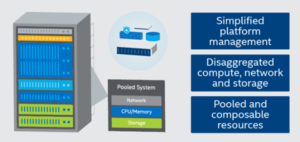Difference between revisions of "Valence"
(Created page with "== Introduction == Rack Scale Design allows considering compute, storage, and networking as disaggregated resource pools that are composed on the fly to meet various needs....") |
(→Introduction) |
||
| Line 7: | Line 7: | ||
The API in addition to supporting composition and release of nodes supports managing them (power-on/off), discovering hardware capabilities, and even collecting advanced telemetry. | The API in addition to supporting composition and release of nodes supports managing them (power-on/off), discovering hardware capabilities, and even collecting advanced telemetry. | ||
| − | Using the RedFish API one could | + | Using software that implements the RedFish API, one could construct nodes to deploy an OpenStack Cloud and with drivers for Nova and Ironic grow and shrink the cloud to meet utilization needs. Hardware flavors could be defined no different from VM flavors for the undercloud. This was take us closer to true Software Defined Infrastructure (SDI). |
| + | |||
| + | [[File:Rack-Scale-Design.png|thumb|Rack Scale Design]] | ||
Revision as of 07:47, 7 September 2016
Introduction
Rack Scale Design allows considering compute, storage, and networking as disaggregated resource pools that are composed on the fly to meet various needs. Disaggregation in addition to allowing hardware refresh at different rates for each of storage, compute, and networking at different rates also allows for more efficient resource utilization. Imagine a cloud that grew and shrank to meet usage by virtue of being connected to a rack that allowed such dynamic composition and release, where you might compose a node with copious storage or another that provided pure compute horsepower.
To bring such a vision to light, the compute industry collaborated to standardize and define the RESTful RedFish API[1]. Intel PodManager implements the RedFish API. The API in addition to supporting composition and release of nodes supports managing them (power-on/off), discovering hardware capabilities, and even collecting advanced telemetry.
Using software that implements the RedFish API, one could construct nodes to deploy an OpenStack Cloud and with drivers for Nova and Ironic grow and shrink the cloud to meet utilization needs. Hardware flavors could be defined no different from VM flavors for the undercloud. This was take us closer to true Software Defined Infrastructure (SDI).

